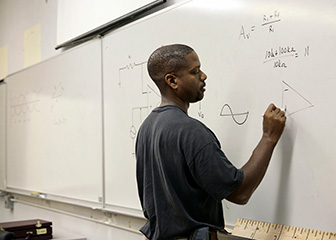How to Become an Electrical or Electronics Engineer About this section

Becoming an electrical or electronics engineer involves study of math and engineering.
Electrical and electronics engineers must have a bachelor’s degree. Employers also value practical experience, so graduates of cooperative engineering programs, in which students earn academic credit for structured work experience, are valuable as well. Having a Professional Engineer license may improve an engineer’s chances for employment.
Education
High school students interested in studying electrical or electronics engineering benefit from taking courses in physics and mathematics—algebra, trigonometry, and calculus. Courses in drafting are also helpful, as these engineers are often required to prepare technical drawings.
Entry-level jobs in electrical or electronics engineering generally require a bachelor's degree. Programs typically last 4 years and include classroom, laboratory, and field studies. Courses include digital systems design, differential equations, and electrical circuit theory. Programs in electrical engineering should be accredited by ABET (formerly the Accreditation Board for Engineering and Technology).
Some colleges and universities offer cooperative programs in which students gain practical experience while completing their education. Cooperative programs combine classroom study with practical work.
At some universities, students can enroll in a 5-year program that leads to both a bachelor’s degree and a master’s degree. A graduate degree allows an engineer to work as an instructor at some universities, or in research and development.
Important Qualities
Active learning. Electrical and electronics engineers have to apply knowledge learned in school to new tasks in every project they undertake. In addition, continuing education is important for them so that they can keep up with changes in technology.
Communication skills. Electrical and electronics engineers work closely with other engineers and technicians. They must be able to clearly explain their designs and reasoning and to relay instructions during product development and production. They may also need to explain complex issues to customers who have little or no technical expertise.
Detail oriented. Electrical and electronics engineers design and develop complex electrical systems and electronic components and products. They must keep track of multiple design elements and technical characteristics during these processes.
Math skills. Electrical and electronics engineers use the principals of calculus and other advanced topics in mathematics for analysis, design, and troubleshooting in their work.
Teamwork. Electrical and electronics engineers must work with others during production to ensure that their plans are being correctly applied. This includes monitoring technicians to see that plans are being implemented properly and devising remedies to problems as they come up.
Licenses
Licensure for electrical and electronics engineers is not as common as it is for other engineering occupations, but it is encouraged for those working in companies that have contracts with the government at all levels. Engineers who become licensed are designated professional engineers (PEs). Licensure generally requires the following:
- A degree from an engineering program accredited by the ABET
- A passing score on the Fundamentals of Engineering (FE) exam
- Relevant work experience
- A passing score on the Professional Engineering (PE) exam
The initial Fundamentals of Engineering (FE) exam can be taken right after graduation from a college or university. Engineers who pass this exam commonly are called engineers in training (EITs) or engineer interns (EIs). After getting work experience, EITs can take the second exam, called the Principles and Practice of Engineering exam.
Several states require engineers to take continuing education to keep their license. Most states recognize licensure from other states if the licensing state’s requirements meet or exceed their own licensure requirements.
Advancement
Engineers may advance to supervise a team of engineers and technicians. Some may move into management positions, such as engineering managers or program managers. Preparation for managerial positions usually requires working under the guidance of a more experienced engineer.
For sales work, an engineering background enables engineers to discuss a product's technical aspects and assist in product planning and use. For more information, see the profile on sales engineers.













